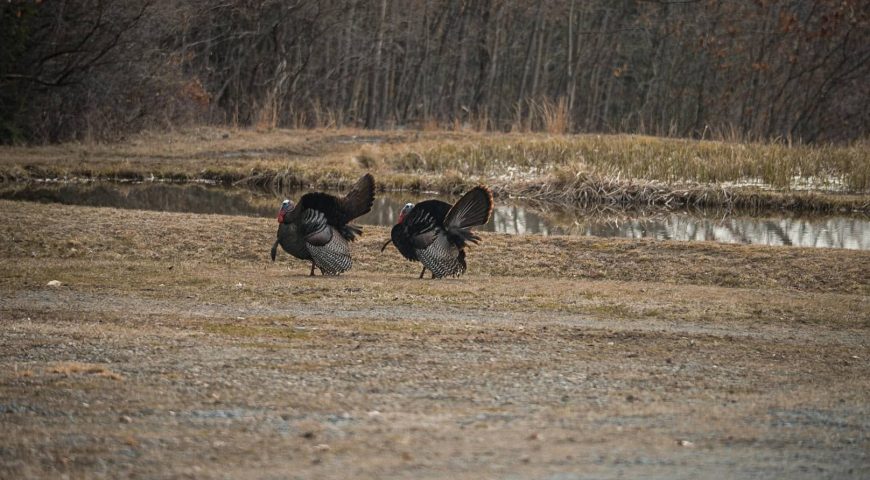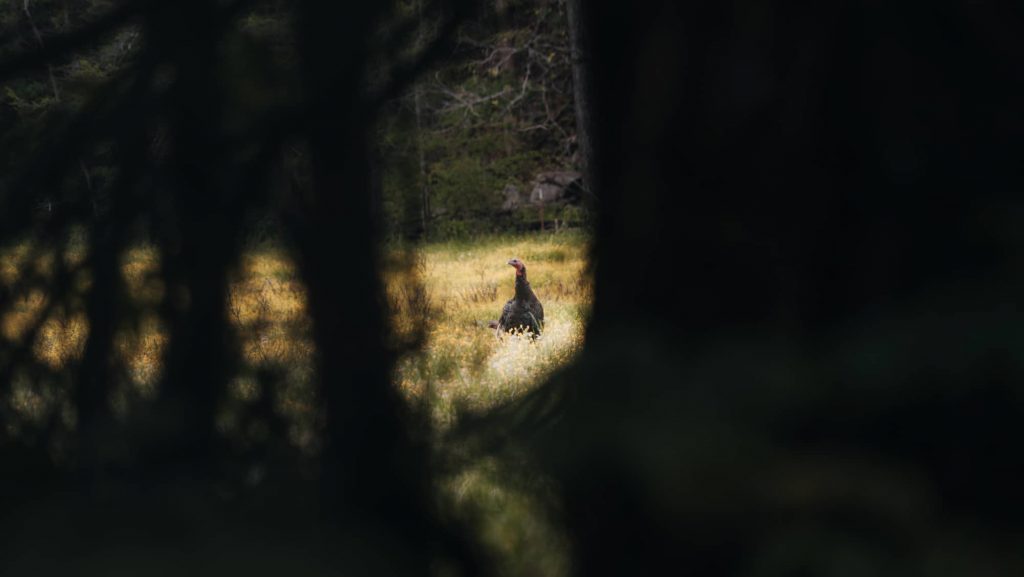
Hunting Pressured Public Land Turkeys
Turkey hunting in the spring is one of the most exciting hunting opportunities of the year. Beautiful crisp mornings with hot gobblers are what we dream of as we start looking at the spring season. When you are hunting pressured public land turkeys, they become challenging to harvest. When turkeys become educated, as they do on public land, they become very elusive.
This article is going to go over a number of strategies that I have used on public land turkeys that have enabled me to have better success, more responses to my calls, and a more enjoyable public land hunt. We also cover some of the most asked turkey hunting questions.
Turkey Call Choice
The number one thing that I have learned from hunting public land is how turkeys respond to calls. If a turkey hears a similar-sounding call regularly and somewhere along the way becomes educated, it will stop responding to that call.
A good example of this is a public land turkey hunt in central Pennsylvania. I found a responsive gobbler in the middle of the season. As I called, I used a slate call and a box call.
Originally he gobbled to the box call. When I switched over to a slate call, his responsiveness decreased. When I switched over to a mouth call he completely stopped responding. I’ve used mouth calls since before I was legal hunting age. I’ve also been involved in competitive turkey calling and had very good success. Additionally, I have always had good responses to my mouth call on private land. Naturally, I switched over to my mouth call but it completely stopped the response.
The next day I went back, used the box call, and called the gobbler and a group of turkeys into sight. I did not end up harvesting him, but I did get close.
What I learned from this is how gobblers attach meaning to different-sounding calls. Obviously, this gobbler had heard a mouth call at some point either earlier on in the season, or earlier on in his life. He learned that a diaphragm meant bad things. On the other hand, he had a higher trust level for the box call. Using calls that are not normally used in your hunting location will help you be successful. Check out our article about the best turkey calls on the market.
Turkey Hunting Movement Strategy
As turkeys get further into the season, they find places where they experience less pressure. They hold up in those areas until they experience pressure or the season ends. This can work out well for a hunter that is willing to travel deep into the woods and is patient.
Early on in the season if I hear a gobbler in a location, and he’s there for about 15 minutes, I’m going to close the distance. I’m going to get as close as I can without getting within eyesight of this turkey. As the season matures and gobblers receive more pressure on public land, I dial it back a bit. Gobblers will get on a strut pattern. Later in the season, I like to listen patiently after getting a turkey to gobble.
Turkey Strut Pattern
I have found that hunting pressured public land turkeys in the middle of the season can be successful if you are patient. Gobblers will find a location and stick to it until they’re bumped. They will usually have a strut pattern inside of that location. This means when you find a gobbler, it is best to wait and listen; especially if he’s being vocal. You can tell which direction that gobbler is moving and identify his strut pattern.
Gobblers will walk back and forth from location to location during the day checking on hands and feeding but also strutting. Once you’re able to catch on to his pattern, and sometimes this takes observing him do it twice or three times, you can make a move to head him off.
Once you are within about 100 yards of his location and on or near his strut pattern, set up and resort to quiet calls. Act like a turkey. Use a branch to scratch some leaves to make it sound like you’re a turkey. I have called in turkeys just scratching leaves before. Scratching leaves with an occasional soft purr and cluck is a recipe for success on public land.
Get There Early
If you have located a gobbler, or have him roosted in a tree the night before, get to your hunting location early. I have ruined hunts before they even started by walking in too late. Instead of coming in at daybreak, consider heading to your hunting area earlier and setting up before daybreak. One cautionary note on this: mark very well where this gobbler is roosted. You can accidentally walk right in underneath them and they will never make a sound. They will fly off the roost and you may never see them again.
There is a healthy medium between getting too close and being too far away. This depends on the area and conditions you’re hunting in. On a wet morning, you can get closer because the leaves are quieter. On a still and dry day, it will be challenging to get into your hunting spot without spooking the turkeys.
Mark Other Hunting Pressure
This is one thing I do that I’m not sure many other hunters do. If I find an area where other hunters are frequently heading into the woods, I mark it on my map. I try not to mess with that area. In spring turkey woods, this gets more challenging because hunters will try to be mobile. If I find an area that is regularly receiving pressure I try to avoid it by around a quarter of a mile. If I have an exact location of where a hunter is I will mark it on my TrophyTracks hunting app and avoid that location.

This is for a few reasons. One, I don’t want to mess with somebody else’s hunting spot. I think it’s disrespectful and I don’t like it when other people come and hunt in my spots. On the other hand, turkeys become used to hunters being in one location. They will avoid that location.
The more hunting pressure turkeys receive in one area the less likely they are to be there. I know this sounds like common sense but it can be super tempting to hunt a spot where you know other hunters regularly go if it looks good.
How Do You Hunt Turkey on Public Land?
Use a calculated approach to hunting turkeys on public land. Keep track of where other hunters are located, and also think through and anticipate the actions the turkeys will make. Use soft-calling techniques appropriate for the situation.
Generally, you should take a more relaxed approach when hunting pressured public land turkeys than you would when hunting private property. Educated toms are reluctant to commit and come into calls.
Sometimes this means that you need to be more patient than you normally would and call with a different strategy. You need to take very calculated movements factoring in the direction and speed of turkey travel and the likelihood of another hunter in the location you are moving to.
After my initial engagement with a turkey, I move smaller distances than I would if I hunted private property. This makes it more realistic to a gobbler. Instead of closing the distance in a 300 yardd chunk, I might move 150 yards twice or 100 yards three times. This varies depending on the situation. If a public land gobbler is making a direct move for private land I’ll move fast to head him off, change calls, and act like a hen that was always there.
Should You Hunt Turkeys in a Field or Woods?
Determining whether you should hunt a turkey in the field or woods, is a big step. On public land, the most important factor is regular hunting pressure. If there is a field that regularly gets hunted, this is not a good place to go. Instead, target woods with good feed sources such as acorns, or some sort of nut tree, or plan for small green areas.
Gobblers will regularly use old logging roads in the woods to strut and travel from one location to another. Setting up on a logging road between two small green areas or feed sources could be a great option.
Looking for opening day gobbler locations? Read our Spring Turkey Hunting Tips | Opening Day Gobbler Hotspots article for first morning setup locations.
What Is the Best Terrain for Spring Turkey Hunting?
Regardless of the area you’re hunting, turkeys favor ridgetops. In areas with lots of agriculture, a wooded ridgetop would be a great place to find turkeys roosting. Turkeys nest in brushy areas. Find a food source nearby a roosting area with close thick vegetation for best success.
The best terrain for spring turkey hunting depends on the location. In areas that are flat, turkeys like to spend time along hedgerows and where wood lines meet fields. In hilly locations, ridgetop fields or woods with nut trees are good places to set up. There are three main things a turkey needs: feed, roosting, and nesting. A place with all three of these is a hotspot.
Regardless, scouting is what will make the difference when hunting pressured public land turkeys. If it looks good but the turkeys are not there, keep moving and find where they are. It’s ultra simplistic, but I have hunted unsuccessfully in areas that seemed perfect but never produced.
What Are the Best Conditions for Turkey Hunting?
The best conditions for turkey hunting are a clear calm brisk morning. Gobblers will feel free to let loose knowing that their vocalizations travel further. Hens are normally more talkative as well. If you are in a location with a population of turkeys you will be able to pinpoint where they are.
Many turkeys have been harvested in the rain as well, but a cool calm morning will lead to a more exciting hunt. A note to this: public land turkeys will learn that hunters like the clear calm mornings and will be on high alert. Later on in the season, hunting turkeys in different weather patterns may lead to the gobblers being more relaxed.
What Is the Best Time to Turkey Hunt?
The best time to hunt turkeys is from 8:00 to 10:00 in the morning when gobblers become free after their hens have gone to the nest. If you can catch gobblers during this time it’ll be very responsive to calls. As the heat of the day comes, turkeys limit movements but amp back up in the evening.
The evening offers good hunting. Turkeys will often get into an evening pattern. If you identify a turkey’s evening habits, it can be a very productive place to set up.

How Long Should You Wait Between Turkey Calls?
Generally, you should wait 5 to 15 minutes between calls. When you hear a hen calling, try to call at the same time as if you’re responding to her. If she is calling more frequently than 5 to 15 minutes then you should be calling more frequently than 5 to 15 minutes.
It’s important not to call another hunter, so you should use your discretion. Generally, I have found it easy to identify if a call is coming from a turkey or another hunter. Hunters use the same sequences repetitively and generally make a few mistakes.
Calling every 5 to 15 minutes Is it good strategy to start. The type of calling that you implement every 5 to 15 minutes should be calculated. Make your calls realistic. It is uncommon for a hen to randomly start out with excited calls. If you have a call sequence that you want to become excited, you need to warm up into it. Make sure to have a realistic close to that calling sequence as well.
Do You Call Turkey Uphill or Downhill?
It is best to call a turkey uphill. This does not mean that turkeys will not come downhill. I have killed turkeys by calling them downhill before but in my experience gobblers will cover ground faster if you are uphill from them. Turkeys generally want to be uphill, so if you are above them it makes your calls more believable.
Gobblers like to strut on ridge tops. If you can find a place where he regularly ends up on top of a hill and call from there you can expect an exciting hunt.
How Loud Should You Call for Turkey?
This depends mostly on the time of year you’re hunting. Early in the season, especially the first few days, you can get away with louder calls. As the season matures, public land gobblers will get scared when they hear high-volume calling. Soft calls are more realistic in some situations.
Some of my most successful hunts have been hunts where I called very softly with clucks, purrs, and yelps. If I’m trying to locate a gobbler, I may use an excited call just trying to get him to respond. After that, I will become quieter. If I have a turkey in sight I will discontinue calling unless I see that the gobbler is losing interest.
A loud call when a gobbler is close will enable him to pinpoint exactly where you are. If he doesn’t see a turkey he will spook. When hunting public land gobblers, call volume makes a big impact. Especially later in the season, softer calls are better. Mix in scratching in the leaves with a stick, and you can make a very realistic scenario.
Do Turkeys Like Ridges or Valleys?
Turkeys like ridges. Oftentimes ridgetops contain the feed that they want and also give them a sense of security. They feel secure because they can use their eyesight to look down over the edge of the Hill.
Many times when calling turkeys, turkeys will be one ridge over from me. I call them down across the valley and up to the other side. This gives them the realistic illusion that there is another group of turkeys on the next ridge over. That said, wide valleys with a good green feed source will also be productive. Remember, the perfect place is only perfect if the turkeys are there.
Field Notes
Hunting pressured public land turkeys are a challenge, but by using the right tools and techniques you can be successful. The TrophyTracks mapping and hunt journaling app allow you to record information about your hunt all in one place. Tagging locations and logging details likely to be forgotten will help you be more successful in coming hunts. The app is free, with a pro version available for more photo storage and features. You can hunt confidently knowing you are using the right strategy. We hope this post helps you become more successful in the turkey woods.
Guest Post by Evan Grimm
Evan Grimm is an outdoor content writer that dives deep into topics to produce informative and practical content. He is a TrophyTracks user and contributor, the owner of ETHIC Digital Products, and is heavily involved in non-profit ministry where he and his family now reside in Alaska.


Comments are closed.